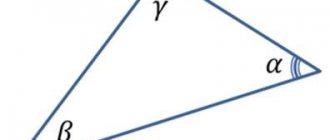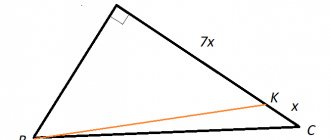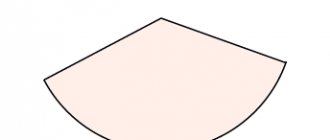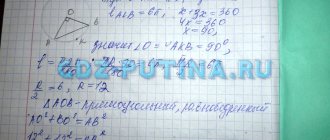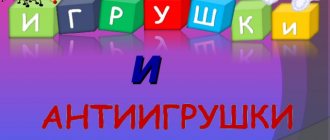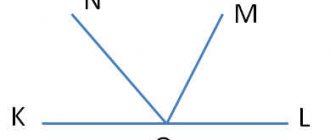Work program on geometry for grade 7 (UMK L.S. Atanasyan).
Personal, meta-subject and subject results of mastering the types of activities of the content of the “Geometry” course
Personal:
1. the formation of a responsible attitude towards learning, the readiness and ability of students for self-development and self-education based on motivation for learning and knowledge, the choice of further education based on orientation in the world of professions and professional preferences, the conscious construction of an individual educational trajectory taking into account sustainable cognitive interests;
2. formation of a holistic worldview that corresponds to the modern level of development of science and social practice;
3. the formation of communicative competence in communication and cooperation with peers, seniors and juniors in educational, socially useful, educational and research, creative and other types of activities;
4. the ability to clearly, accurately, competently express one’s thoughts in oral and written speech, understand the meaning of the task, build an argument, give examples and counterexamples;
5. critical thinking, the ability to recognize logically incorrect statements, distinguish a hypothesis from a fact;
6. creativity of thinking, initiative, resourcefulness, activity in solving arithmetic problems;
7. ability to control the process and result of educational mathematical activity;
8. the ability to emotionally perceive mathematical objects, problems, solutions, reasoning.
Metasubject:
.1 the ability to independently plan alternative ways to achieve goals, consciously choose the most effective ways to solve educational and cognitive problems;
2. the ability to control the result and method of action at the level of voluntary attention and make the necessary adjustments;
3. the ability to adequately assess the correctness or error of completing a learning task, its objective difficulty and one’s own capabilities to solve it;
4. conscious mastery of logical actions of defining concepts, generalizations, establishing analogies, classifications based on independent choice of grounds and criteria, establishing generic connections;
5. the ability to establish cause-and-effect relationships, build logical reasoning, inferences (inductive, deductive and by analogy) and conclusions;
6. the ability to create, apply and transform sign-symbolic means, models and diagrams to solve educational and cognitive problems;
7. the ability to organize educational cooperation and joint activities with the teacher and peers: determine goals, distribute the functions and roles of participants, interact and find common ways of working; ability to work in a group: find a common solution and resolve conflicts based on coordinating positions and taking into account interests; listen to your partner; formulate, argue and defend your opinion;
Project topics in geometry and planimetry
Sample topics for research papers in geometry and planimetry:
Geometric parquets Geometric scissors in problems. Geometric constructions and their practical application Geometric tales Geometric tales on the topic “Length” Geometric figures Geometric figures in the design of paving slabs. Geometric figures in the modern world Geometric figures in the Pythagorean theorem. Geometric shapes around us Geometric fractals Geometric patterns on dishes. Geometric dictionary Geometric locus of points Geometric solution of non-geometric problems. Geometric constellation Geometry 9th grade in puzzles Geometry by Lobachevsky. Definition of a straight line Geometric ornament of the ancient Arabs and its modern interpretation Geometry in the architecture of buildings and structures Geometry in geodesy Geometry in painting, sculpture and architecture Geometry in winter Olympic sports Geometry in the beauty of ornaments Geometry in fashion Geometry in folk art Geometry and art Geometry and cryptography Geometry and character Geometry of measurements Geometry of measuring instruments Geometry of beauty Geometry on paper Geometry on checkered paper Geometry on a plane Geometry of a circle Parallelogram geometry Geometry of dance Geometry of a triangle Geometry. Remarkable theorems “Double bisector” of a triangle Two remarkable theorems of planimetry Movement of geometric figures on a plane Movements on a plane and their application to geometric constructions Cartesian sheet Cartesian coordinate system Cartesian coordinate system on a plane Dividing a circle into equal parts Dividing a segment into equal parts Dividing the side of a square in a given relation by folding. Length and its measurement Circumference and area of a circle. Proof of Pythagoras' theorem Proof of Morley's theorem for a right triangle Proof of Morley's theorem for an isosceles triangle Proof of Napoleon's theorem Additional properties of the parallelogram Euclidean and non-Euclidean geometry. Euclid's fifth postulate Another property of trisectors of a triangle. The dependence of the number of segments on the number of points marked on a line. The dependence of the number of diagonals of a polygon on the number of its vertices. Riddles of the circle Riddles of the triangle Mysterious and unique geometry Mysterious ellipse The task of constructing the middle of a segment defined by its ends using various tools. Problems for construction Problems for construction with one ruler Problems for construction with a compass and a ruler Problems in geometry Remarkable curves in descriptive geometry Remarkable theorems of planimetry Remarkable points and lines of a triangle Entertaining geometry An entertaining and educational trip to the country “Geometry” Interesting problems in geometry and drawing Entertaining problems (geometric problems, puzzles with matches) Geometric probability Famous problems of antiquity. Trisection of an angle Golden section in geometry Golden triangle in problems From the history of the emergence of areas. From the history of the emergence of trigonometric terms. From the history of the Pythagorean theorem Isoperimetric theorem Studying the method of tiling a plane with equilateral pentagons Inversion as symmetry about a circle Using geometry in solving some types of trigonometric problems Using plane models when studying the topic “Area” Studying the influence of the radius of a circle on the circumference and area of a circle Studying the properties of polygons Measuring the height of a building in an unusual way Measuring the height of an object Measuring length Measuring large distances. Triangulation Measurements on the ground in the history of our region Measuring instruments are our assistants Measuring work on the ground Image of points on the coordinate plane Study of symmetry in nature How to find the area of a hole? Square Pearson Square “Pythagorean Square” in my life Square wheel - truth or myth? Squaring a circle Key problems in teaching 7th grade geometry Geometry wheel Complex numbers in geometry problems Square wheel - truth or myth? Magic squares Median and bisector Medians of a triangle and areas of figures Metric system of measures Metric theorems of planimetry Mysticism of the triangle Many-sided symmetry in the world around us The variety of the circle Polygons Polygons. Types of polygons A set of problems for calculating the areas of figures for students in the 5th and 6th grades Names of geometric figures in surnames Finding the area of plane figures through the area of a rectangle Basic geometric information Celestial geometry. Geometry of snowflakes Impossible figures Non-Euclidean geometry Unknown about the famous triangle Unknown pages of the Pythagorean theorem Some problems for constructing a parallelogram Several proofs of the Pythagorean theorem Several approaches to solving geometric problems Several ways to solve one geometric problem Several ways to solve a planimetric problem New signs of the equality of triangles. Triangles About coordinates with a smile About some remarkable theorems of geometry About the midline of a trapezoid About the Pythagorean theorem Generalization of the formula for the radius of a circle around a right triangle to the multidimensional case Generalization of the formula for the radius of a circle around a right triangle to the three-dimensional case Generalizations of the problem of the smallest sum of distances from two points to a straight line Circle in Cartesian coordinate system Circle of nine points Circle and circle around us. Determining the distance to an object. Rangefinder Determination of the center of gravity by mathematical means Origami and geometry Orthotriangle and its properties Features of construction on checkered paper From a segment to a vector From a parallelogram to the golden ratio Discovering non-Euclidean geometry Segments Parallelogram and trapezoid Parallelogram and clothing design Parallel lines Parallel translation and rotation. Parquets and ornaments Parquets on a plane Parquets, mosaics and the mathematical world of Marius Escher. Parquets: regular, semi-regular. Paradox M.K. Escher. Perimeter and area of polygons Pythagorean pants. Are all sides equal? Areas of “composed” figures Areas of geometric angles Areas of polygons Area of an orthogonal projection of a polygon Area of a rectangle, units of area measurement. Area of a trapezoid Following in the footsteps of the Pythagorean theorem We repeat the chapter “Triangles” Similar triangles Similarity in life Similarity of triangles Similarity of triangles in solving problems and proving theorems. Let's talk about a rhombus Finding an angle in geometric problems Useful geometry Constructing acute angles on checkered paper Constructing lines in the polar coordinate system Constructing regular polygons Constructing regular polygons using a ruler and compass. Construction of regular n-gons with compass and ruler. Regular polygons Practical geometry Practical orientation in the study of geometry Practical applications of the parallelogram and its types Practical application of geometry Practical application of the signs of equality of triangles. Practical application of the Pythagorean theorem Transformation of the square Napoleon's transformation of polygons Napoleon's transformation of quadrilaterals Approximate construction of regular polygons. Signs of a parallelogram Signs of similarity of polygons Signs of similarity of triangles Signs of equality of triangles Signs of equality of quadrilaterals Application of the theorems of Cheva and Menelaus Application of the theorems of Cheva and Menelaus for solving problems of increased complexity Application of trigonometry in planimetry Proportional segments in a triangle Proportional segments. Methods for solving problems The simplest problems for constructing A simple and inexhaustible triangle Straight line and Euler's circle Rectangle in visual geometry problems Right triangles Journey through the land of geometry Euclid's fifth postulate. Non-Euclidean geometry Isosceles trapezoid, its properties Equal and equipartite plane figures Equal polygons Equally self-intersecting broken lines Various proofs of theorems of elementary geometry not studied in school. Cutting and folding polygons. Cutting a square into equal parts Cutting figures into equal parts Distance between remarkable points in a triangle Solving geometric problems using grids Solving geometric problems with practical content Solving geometric problems using algebra and trigonometry Solving inscribed and circumcircle problems Solving the problem of squaring a circle in its medieval formulation Solving complex geometric problems using the rectification method. Rhombus and its properties. Problem solving. Rhombus and square Properties and characteristics of an isosceles triangle Properties of the median of a right triangle drawn to the hypotenuse. Properties of quadrilaterals Symmetry in geometry Symmetry on a plane Snowflakes of geometry Relationships between the sides and angles of a triangle Sophisms and paradoxes Treasures of geometry Methods of measuring the height of an object in a real situation. Sum of the angles of a triangle Surprises of the bisector The mystery of the four angles The secrets of the star pentagon Morley's theorem Pythagorean theorem Pythagorean theorem outside the school curriculum Pythagorean theorem and its relevance. The Pythagorean theorem and various ways to prove it. Ptolemy's theorem Thales' theorem Ceva's theorem Ceva's and Menelaus' theorem Cosine theorem Menelaus', Ceva's, Ptolemaios' theorems Relativity theory and geometry Fermat-Torricelli point Point, straight line... what is it? Trapezoid Triangle Triangles Reuleaux triangle Triangle and circle Triangle is the youngest of the polygons. Three signs of equality of triangles Trisection of an angle Angles and segments associated with a circle. Amazing square Patterns of polygons Shapes of constant width. Reuleaux triangle. Figures drawn with one stroke. Flag geometry Flexagons Formulas of Heron and Brahmagupta Formulas for finding the areas of a triangle Flower geometry Center of mass and its application in solving problems Central symmetry Central symmetry as a type of movement Four remarkable points of a triangle Quadrilaterals Quadrilaterals in our life Quadrilaterals: their types, properties and characteristics Numerical methods for calculating the areas of figures complex shape. Extreme problems in geometry. Ellipse.
